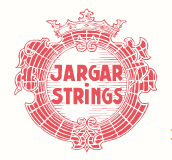

About 1950 Danish cellist Jarl Hansen watned more from his cello than gut strings could provide. As a member of the Royal Danish Opera Orchestra he became increasingly interested in string quality and sound, and for years he experimented in his spare time - until 1956, when he was ready to start his own company, Jargar Strings.
What Jarl Hansen developed was a steel core based string, wound with thin threads of pure or alloyed metal. These new strings had a warm and brilliant tone and furthermore much greater stability, durability and strength than gut strings. These qualities quickly made Jargar strings highly popular throughout the classical mucis world. And still Jargar provides musicians around the world with handmade, powerful and uniquely responsive strings.
Jargar violin strings are all made on a special, flexible steel core. The A, D, and G are all wound with thin threads of metal - aluminum, copper and different alloys. The strings produce a big, powerful, distinct and well-balanced tone.
The production of Jargar viola strings is based on a special, flexible stel core, like the violin strings. All viola strings are wound with thin threads of metal - aluminum, copper, and different alloys. They also produce a big, powerful, distinct, and well-balanced tone.
For the Jargar cello strings a special flexible steel core is used. All strings are wound with thin threads of metal - aluminum, copper and different alloys. The strings produce a warm, brilliant, and powerful tone. The G & C strings are also available with an upper winding of pure silver, which make the sound more like that of gut strings.
Also available for cello are the following A strings:
"Special" - a little thicker and more powerful than the standard A string.
"Superior" - a further development of the "Special". The power of this string has been much increased and so has the warmth and brilliance. Ideal for solo performing, but also works for orchestra playing if a bigger sound is desired.